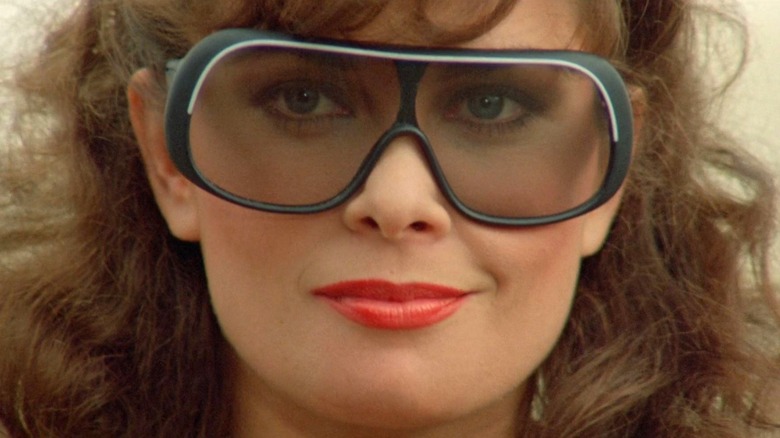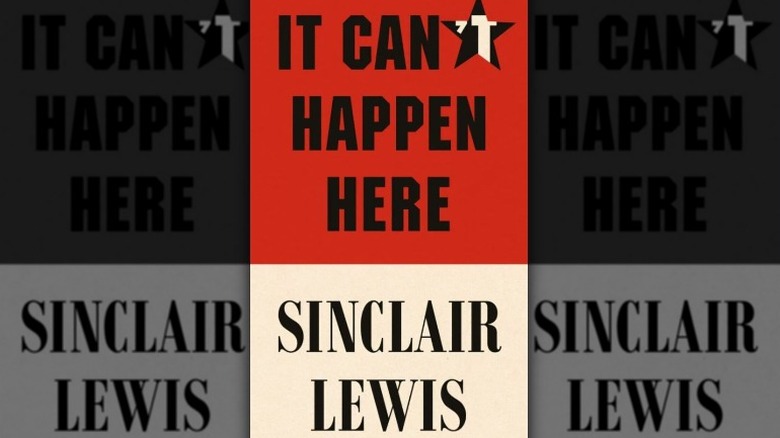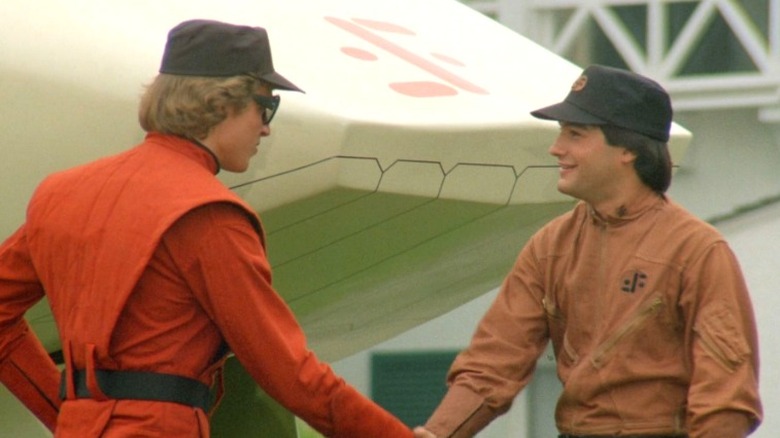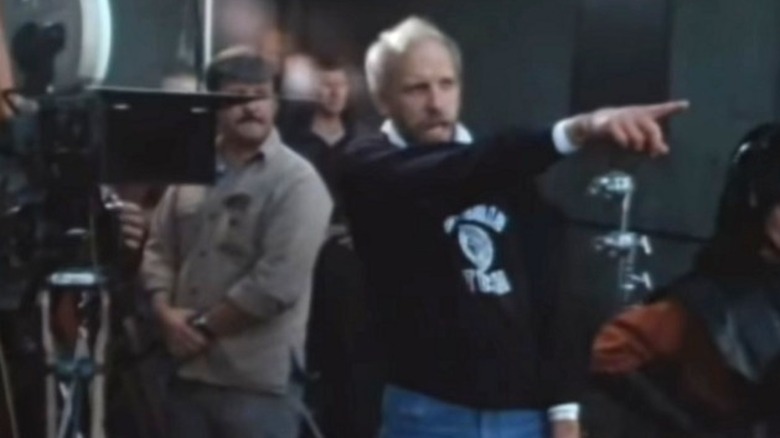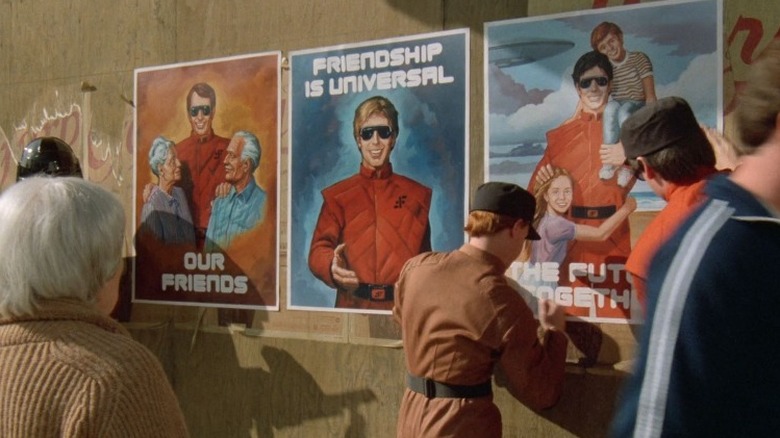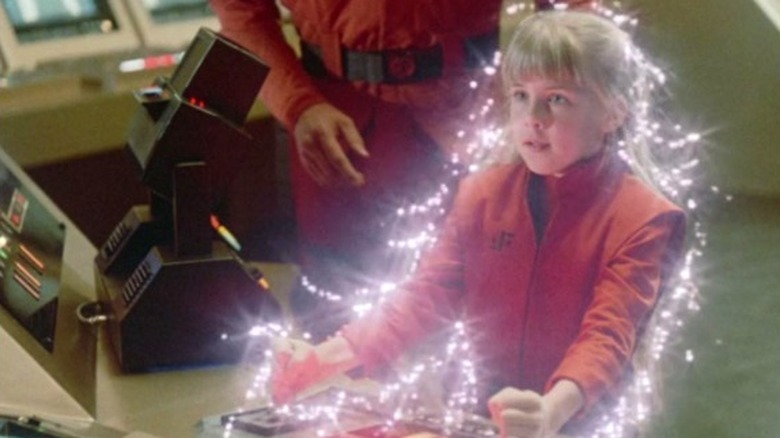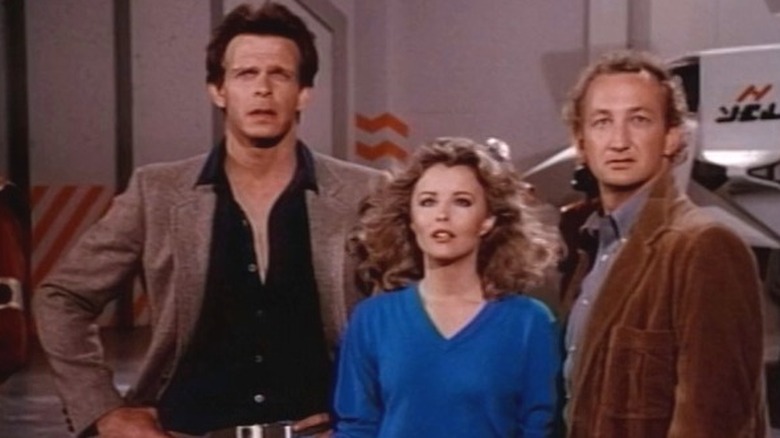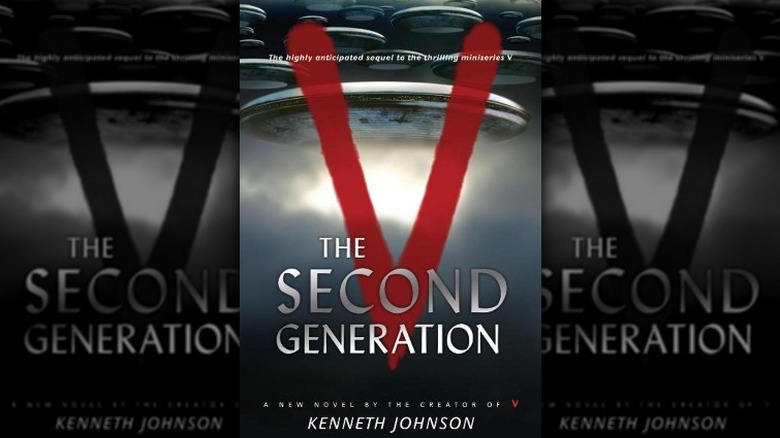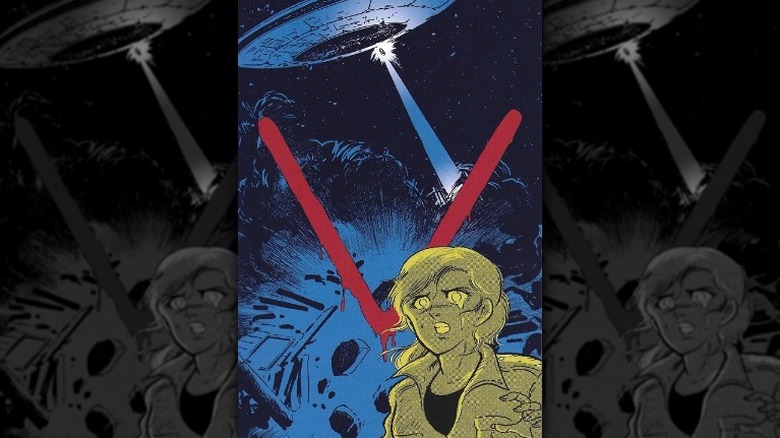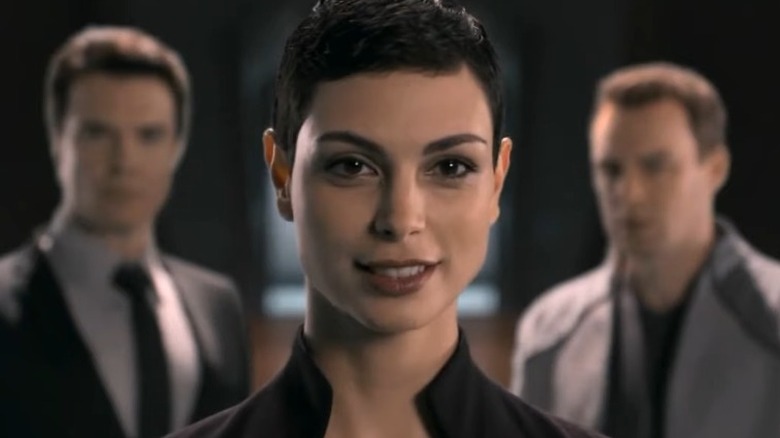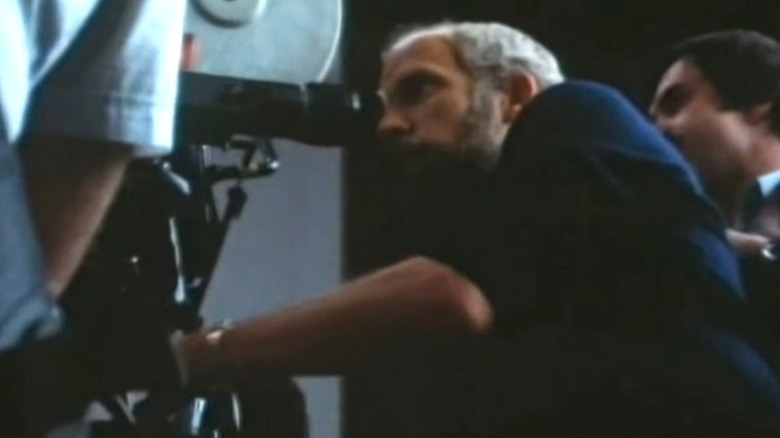The Rise And Fall Of The V Franchise
During the 1980s, the big three networks — ABC, CBS, and NBC — were in a constant battle to draw audiences. At the beginning of the decade, NBC had fallen behind and was sorely in need of a television event that would engage audiences and take advantage of the public's hunger for sci-fi in the wake of the "Star Wars" trilogy. This arrived in the form of "V," a big-budget miniseries about visitors from outer space.
Broadcast for the first time in 1983, "V" was far more than a science fiction miniseries — it was also a cautionary tale about the tactics used by fascist regimes to take over a country, while also focusing on how everyday people respond to an occupying force. The mix of an intriguing plot, excellent performances and special effects was an immediate hit, attracting 40% of viewers during the broadcast of the first episode (via The New York Times). But people wanted more, and NBC responded by greenlighting a second miniseries and a TV series, as well as licensing different types of merchandise like novelizations, comics, and toys.
Sadly, the results were not what producers expected. "V: The Final Battle" had good ratings but failed to capture the themes and tone of the original. The franchise, which had started as a commentary on the threat of fascist regimes, had turned into a sci-fi supernatural action adventure, and things only got worse from there. "V: The Series" was produced with only part of the cast and half the budget; ratings dropped and the show lasted only 19 episodes. Additional efforts were made to revive "V" in the form of remakes, sequel novels, and even a manga, but none of these attempts were able to replicate the success of the original. Here's the story of the rise and fall of the "V" franchise.
The original series was inspired by a novel
In the early 1980s, the creator of "V," Kenneth Johnson, was one of the most respected writers and directors in TV. He had produced "The Six Million Dollar Man" and created the show's successful spinoff "The Bionic Woman" as well as the late 1970s hit "The Incredible Hulk," writing and directing multiple episodes. These series of successes allowed him to establish a close relationship with then-president of NBC Brandon Tartikoff, so when Johnson came with an idea for a movie about America being taken over by a fascist group, Tartikoff was more than happy to listen to his pitch.
According to an interview made for the French DVD release of the original series, Johnson's concept was inspired by the 1935 Sinclair Lewis novel "It Can't Happen Here," which tells the story of a man who uses fear and the promise of returning to an idyllic past to win the presidency and then take over the country with his own paramilitary group. The intent of the novel was to warn that America wasn't immune to charismatic leaders seeking total control. The concept captivated Johnson, but instead of fascism emerging as an internal threat, he decided to capitalize on the Cold War fears of an invasion and introduce an external force.
Tartikoff and Johnson decided to rework the movie as a miniseries. The story would revolve around an external army introducing themselves and their leaders as friendly visitors who would then use techniques like visual propaganda, media control, recruiting younger people, finally using fear to discredit any opposing forces in the eyes of the public and eventually take control. They both loved the idea but realized that Cold War threats like the Soviet Union or China wouldn't be able to maintain such control for a long time, so they looked up to the stars for a solution.
Using alien invaders made the series more believable
In 1983, fears of nuclear attacks and invasions had replaced worries about fascist regimes triggering a world war. To capture people's attention, Johnson's script would have to reintroduce the concept in an intriguing way, using invaders from outer space as the main antagonists. The visitors, as they were called in the series, would wear red and black uniforms and use symbols that would resemble nazi iconography while still feeling alien and new. They would arrive with the promise of peace and scientific exchange, and use people's trust and desire for power to slowly take over society, using techniques employed by real fascist regimes.
NBC loved the idea. After all, they were repeatedly losing in the ratings, and they needed to broadcast something that would feel like an event (via Jane Badler Fans). This explains why Tartikoff approved Johnson's story immediately and without any notes, something that rarely happens when pitching a TV production. NBC also gave Johnson a lot of control, but there was a catch: NBC needed "V" to become part of their lineup sooner than expected. In fact, Johnson had only two and a half weeks to start filming the two-episode miniseries, something the director wasn't completely sure he would be able to accomplish.
The director's experience and luck saved the miniseries
In a 2008 interview with Ain't it Cool News, Kenneth Johnson explained how in the early 1980s, most shows had between four and five months to start production. Getting everything ready for an event miniseries in less time would be incredibly difficult, but Johnson wasn't a newcomer. His experience creating, writing and directing "The Bionic Woman" and "The Incredible Hulk" paid off, as he was used to shooting more cinematic-looking shows with limited budgets and time. He also brought in the crew from his last show, something that allowed him to work and communicate fast and efficiently.
When filming started, they had stages and props ready. The team had come up with truly unique designs for the aliens' uniforms, weapons, and shuttles. These last had the additional advantage of being easily reassembled to create different types of spacecraft (via Behind the Science Fiction). They also used techniques employed in "Star Wars," like prosthetics and matte paintings. But the show could only go so far without a good cast.
Johnson got incredibly lucky during the casting process. In an interview for the French DVD release of "V," he explained that, for the adventurous reporter Michael Donovan, Johnson wanted a relatively unknown actor with the presence of a leading man. He ended up choosing Marc Singer, who had experience in Shakespeare plays as well as films such as the fantasy epic "Beastmaster." In the same interview, Johnson described how he'd worked with actor Faye Grant in a previous movie, casting her to play Juliet, the unlikely leader of the rebellion, due to her ability to portray both vulnerability and strength. Finally, for the role of the visitors' second in command, Diana, the team wanted an actor capable of dominating a room with a few gestures and words. After rejecting multiple hopefuls who played the role as an overtly malevolent antagonist, Johnson found their Diana in Jane Badler (via The Visitors Vids).
V: The Original Series was a marketing and ratings success
Once filming was completed, Johnson saw the first cut of the miniseries. Even without any special effects, he was able to realize the team had made something special. The only remaining question was how to convince people to tune in for the first episode. To answer this, Johnson took a lesson from history books and, remembering German World War II propaganda, proposed the creation of posters depicting the visitors smiling next to children and elderly people with the message "Friendship is Universal." Three weeks before the release date, the posters were to be placed in the subway and train stations of different cities, with no references to a TV series or network. Two weeks before the first episode aired, the advertisement team would then send groups of young people with spray cans to publicly draw a V sign on top of the posters, a symbol of victory used in World War II by resistance groups in occupied territories. Then the title "The Battle Begins on NBC ” was added (via Jane Badler Fans). The results were nothing less than outstanding.
After repeatedly falling behind ABC and CBS, NBC finally got its moment of glory. According to The New York Times, 40% of people watching TV in the U.S. at the time tuned in to watch the first episode of "V," and while only 24% came back for the second part, it was still considered the first hit for NBC in a while. People wanted more, and some even thought that toys were already available for purchase, as a shuttle and figures for John and Diana were shown in the series. However, this were apparently just a model used for special effects shots and a pair of modified figures from other lines (via Secret Galaxy). The demand for merchandise and additional content was so high that NBC greenlit a second three-episode miniseries, but catching lighting on a jar twice isn't easy — especially without the creator in the director's chair.
V: The Final Battle deviated considerably from the original
After the original episodes, Johnson supervised the script for the sequel miniseries. Sadly, even though he was satisfied with the result, NBC chose a different director, and made some changes Johnson didn't agree with. In an interview at the 2019 San Diego Comic-Con, the director complained that in the original screenplay, Ham Tyler had to use a wheelchair, an element that was removed at Michael Ironside's request. He also wasn't a fan of the supernatural abilities given to the human-visitor hybrid Elizabeth.
As he explained to Ain't it Cool News, "I have only really seen about 30 seconds of "The Final Battle" ... and in those 30 seconds, I watched them make every wrong choice they could make ... and I knew I'd never be able to deal with seeing the whole thing."
Despite not receiving the ratings and critical acclaim obtained by the original miniseries, "V: The Final Battle" was still considered a success. As reported by The New York Times, a third of Americans watching TV saw the highly anticipated sequel, defeating ABC's "The Last Days of Pompeii." In addition, Ham Tyler became a fan favorite and, despite using unexpected fantasy elements, the episodes offered viewers an acceptable ending. Sadly, the declining ratings forced NBC to make a drastic decision in regards to the future of the franchise.
Budget and time issues hampered V: The Series
Kenneth had intended for the first miniseries to function as a pilot for a TV series, which is why the story seems incomplete (via Secret Galaxy). The pilot's ending hints at Rose's possible pregnancy, while Michael's child remains abducted by the visitors. Furthermore, the potential allies for the resistance in the form of a rebellious visitor faction and the mysterious alien enemy they refer to are also left unexplained. Johnson saw his plans realized, but not as he originally intended. NBC ordered a sequel miniseries and a TV series to complete the story, but this offer came with a catch.
In an interview for "The V-Files Book Five: The Conclusion," executive story consultant David Ambromowitz explained that the TV series had to be made with half the time and budget (via Starlogged). The results were evident: Only a few of the main characters remained, and many of them were killed off or simply never shown again. The TV series is also infamous for the amount of times it reused footage. Shots involving special effects, in particular, were broadcast several times. The writing also suffered considerably, with character interactions and plots resembling more a cheap melodrama than a sci-fi thriller. It didn't help that the visitors' wardrobe and hairstyles changed drastically to adopt the fashion seen on TV shows of the era. In the end, "V: The Series" was unable to retain the attention of the public, and the show was canceled after only 19 episodes.
Reboots for V: The Series were written but never filmed
"V: The Series" ends with a cliffhanger as Elizabeth, Robin's hybrid daughter who had quickly grown into a full adult with superhuman abilities, boards a shuttle to meet with the visitors' leader. According to Visitor Database, the plot was expected to be resolved in an unfilmed 20th episode called "The Attack." The story would have served as a soft reboot, killing an important character and introducing a new powerful relic that, if obtained, would allow Elizabeth to overpower the visitors.
A few years later, in 1989, Warner Bros. tried to revive the series once more. J. Michael Straczynski, who went on to write the sci-fi show "Babylon 5," was assigned to write a script for a "V" reboot; this time, the rebellion found itself severely weakened after losing Michael, Juliet and Elizabeth. A powerful attack by the visitors left Earth under their control, and the only remaining member of the team, Ham Tyler, was leading a new resistance group from Chicago. Interestingly, this newly formed team would try to continue Juliet's mission to contact potential allies from outer space, a plot featuring prominently in a future attempt by original creator Kenneth Johnson at relaunching the franchise.
Several novels were published after the series was canceled
The popularity of "V: The Original Miniseries” and "V: The Final Battle" led to the publication of different novelizations. The first one summarized the original and sequel miniseries, but the rest would tell stories about the main characters and new resistance groups before and after the events of the shows. According to Gizmodo, the first books were intended to introduce some characters from the upcoming "V: The Series," but the strict deadline led to some inconsistencies between the books and the show. The tone is also different, aiming at a more adult audience in terms of violence, and occasionally venturing into different genres, like horror.
In 2004, Johnson had a chance to discuss a potential sequel to "V: The Original Series" with a network. The conversations ended without an agreement, but led Johnson to realize how much he wanted to tell his story. After years of work, he wrote "V: The Second Generation," a book that ignores the events from "V: The Final Battle" and "V: The Series" as well as any other novels. The story takes place 20 years later, after Juliet and Elias send a signal to outer space, hoping to find and form an alliance with the enemies of the visitors. The resistance has been almost decimated, but just as everything seems lost, the remaining fighters are visited by another species of aliens who offer their assistance (via Ain't It Cool News).
The story also deals with a common element of Johnson's work: discrimination. After two decades of occupation, many people have had hybrid children with the visitors; this group faces backlash from a population who sees them as a reminder of the occupying alien force. The novel received positive reviews, praised for its engaging style and relevant commentary on social issues while giving the franchise a satisfying conclusion.
Younger audiences were able to follow the story in comics and manga
As with other TV series of the time, the success of "V" led to the publication of an official comic; in 1985, DC published a series drawn by Carmine Infantino and written by Cary Bates. The story seems to take place in a scenario where humanity and the visitors are in an open conflict, except for certain neutral areas. Given the publication date, it's fair to assume that the comics were planned to serve as a companion to "V: The Series," but declining interest in the show made this a relatively short run, lasting only 18 issues.
Meanwhile, the show's popularity across the Atlantic was big enough to draw the attention of legendary manga artist Go Nagai. In 1989, the author of classics like "Mazinger Z" and "Devilman" published a manga drawn by Tatsuo Yasuda based on "V: The Original Miniseries" and "V: The Final Battle." The manga summarizes the events of the first miniseries but, as explained by the YouTube channel Au rayon mangas, it lacks more complex dialogue and focuses mostly on action, due to the story only lasting two volumes. Yasuda's classic style is also used to make the visitors and their actions more repulsive (via Meganerd). Unsurprisingly, the manga is relatively unknown outside of Japan, and didn't do much to revive interest in the franchise.
The 2009 remake missed the mark
In 2009, Scott Rosenbaum, known for producing successful series like "Chuck" and "The Shield," spearheaded a "V" revival based on the original series. Kenneth Johnson was still credited as the creator, but had no involvement in writing or directing the new show, which told the story of the arrival of a group of alien visitors led by Anna, portrayed by Morena Baccarin. It deviates considerably from the 1980s miniseries, but incorporates some recognizable elements like the visitors hiding their reptilian nature as well as their plans to take over the planet.
As Collider explains, one of the most interesting changes was that the visitors' takeover doesn't begin with their first appearance; in fact, it's been gestating for years. By the time the visitors arrive, they've already infiltrated institutions like intelligence agencies and religious organizations. As in the original miniseries, the show explores the possibility of losing a family member as they join the invading force. However, this time the visitors' leader Anna and her daughter Lisa experience a similar situation, as Lisa starts to develop empathy towards humans and reconsider her mother's plans.
Although the 2009 revival is an interesting new take, it failed to draw the same level of attention achieved by the original miniseries. According to Johnson himself, the producers didn't understand what "V" was really about, and to their credit, they admitted it (via Cherry the Geek TV). It also suffered from budget limitations that affected the series visuals, which featured prominently during scenes taking place inside a mothership or depicting the visitors without their human skin. The show only lasted two seasons and earned a 60% score in Rotten Tomatoes — 7 points lower than "V: The Series."
The creator is trying to turn V into a feature film
Kenneth Johnson hasn't stopped trying to bring his vision of "V" to life. In 2018, he announced that he had secured financing from Desilu Studios to make a trilogy of films based on the franchise (via Film School Rejects). Sadly, as The Hollywood Reporter explained, this investor ended up being a scammer pretending to represent the company behind classic series like the original "Star Trek" and "Mission: Impossible." Johnson and his team managed to get enough funds to start scouting for locations and work on some concept art, but they were devastated to find out the man offering them funds and creative control was lying.
During an interview at the 2019 San Diego Comic-Con, however, Johnson assured the audience that the team had partnered with a new producer and were exploring alternatives. He also expressed how excited he was with the current designs of the mothership, and the possibilities offered by modern visual effects technology. In regards to casting actors from the original miniseries, he said that they would be the perfect age to portray the older roles of the movie. Johnson also went into some details, explaining that the new film would maintain the basic elements that made "V" so successful, as the resurgence of fascism has become painfully relevant in recent years. He added that the story won't be a period piece, though, and that it would be adapted to the drastic changes in technology the world has experienced through the last 40 years.
